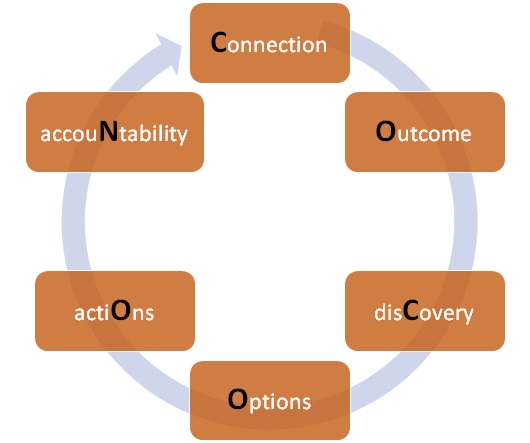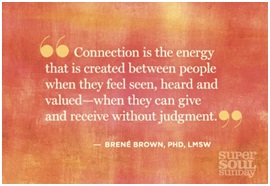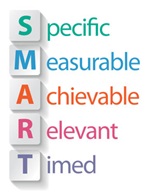A Coaching Model Created by Maimon Md. Arif
(Transformational Coach, MALAYSIA)
 My coaching model COCOON
My coaching model COCOON
I am a life-long learner. My curiosity and thirst for learning was what allowed me to grow and has motivated me throughout my career. This same value landed me on my coaching journey. I took up a coaching certification to test-out a friend’s suggestion that I am a natural coach.’ Along the way, I found myself and found a connection between coaching and my life purpose.
My coaching model is inspired by the [i]GROW (Goal, Reality, Opportunity & Way forward) model, a transformational coaching model, and [ii]OSCAR (Outcome, Situation, Choices, Actions & Reviews)a self-development, professional efficiency, and performance development coaching model.
The elegant simplicity of the GROW model is how I first experienced pure coaching during peer coaching’ and in the ‘mentor coaching’ classes. However, my years of working in a manufacturing environment have embedded the culture of continuous review in me via PDCA (Plan, Design, Check & Act), an iterative four-step management method for the control and continuous improvement of processes and products. OSCAR is comparable to PDCA, with the added Review step, a continuous self-learning step in the model.
In my exposure to the NGO world, I learned that to create change, start with connecting, building a connection – a relationship that is based on trust. I think this is similar in a coaching partnership.No coaching can happen unless the client feels safe, connected, and has trust not only in the coach but also in the process. Connection and safe space are the added components of my coaching model. This is how I approach coaching, how I coach, and who I coach. In coaching, I found my purpose: to be a catalyst to build leaders that will create impact and are empowered to grow. I call my model ‘COCOON’.
COCOON as defined by the Cambridge Dictionary is:
(1) the covering is made of soft, smooth threads that surround and protect particular insects during the pupa stage as they develop into adult form.
(2) a safe, quiet place.
COCOON Model

I learned decades ago in my science class that, in the safety of the cocoon, a lot of activities take place. The caterpillar body breaks down to be developed into a new form, be it a butterfly or a moth -the insect it is meant to be. That is how I visualize a coaching session to be; like being in a cocoon and the client undergoes transformation like the caterpillar.
SAFE SPACE
My Cocoon model is a safe space where coaching happens, a client feels safe to be vulnerable, to be open, knowing that there is no judgment. As a coach, I am present, actively listening and supporting so that the client can grow, transform, and move forward.
COCOON stands for:
Connection:(Oxford Dictionary) a relationship in which a person or thing is linked or associated with something else.
 No coaching can happen without trust. Therefore, first and foremost, the coach and client have to have a connection. Both must establish a relationship and trust, to onboard the client by clarifying each other’s roles and responsibilities. This entails setting up a safe space, like a cocoon, where the client will be willing to be vulnerable and trust in the process to transform.
No coaching can happen without trust. Therefore, first and foremost, the coach and client have to have a connection. Both must establish a relationship and trust, to onboard the client by clarifying each other’s roles and responsibilities. This entails setting up a safe space, like a cocoon, where the client will be willing to be vulnerable and trust in the process to transform.
Safespace means setting boundaries like:
The coach starts the coaching session by helping the client feel comfortable, safe, and present. For example, they might do a breathing exercise or meditation together.
Objective: (Oxford Dictionary) a thing aimed at or sought; a goal.
Understanding the objective of the coaching session starts with having a deep discussion on the issues the client brings. Things are not always what they seem to be, a drip on the ceiling does not necessarily point to the location of the leak on the roof. The coaching outcome is only as good as a clear coaching agreement. It is therefore of utmost importance that the coach and client identify the desired outcome of the session and how it links to the long-term goal of the client. Asking the client powerful questions like:
disCovery:(Cambridge Dictionary) the process of finding information, a place, or an object, especially for the first time, or the thing that is found.
The teacher kindles the light, the oil is already in the lamp – Sufi Saying
At this stage, both coach and client discuss the ‘here and now’ situation. The coach supports the client by inviting the client to go through deep self-reflection and assessment of the situation. The coach offers feedback and gets the client to examine the client’s assumptions, encouraging the client to expand awareness for greater clarity about their limiting beliefs, their motivation. This may be a very challenging and emotional journey for the client. The coach is there to support the client by holding space, being present, and non-judgemental. Sometimes leaders just need to permit themselves to ask for help. The coach’s job is to be present, be curious about the client and not the client stories (‘to not go down the rabbit hole as Lorna Poole says), ensure the client stays in focus and is ‘live’ with the issue in discussion. The coach is the client’s active mirror.
Options: (Cambridge Dictionary) one thing that can be chosen from a set of possibilities, or the freedom to make a choice.
Becoming AWAKE involves seeing our confusion more clearly –(RUMI? / CHÖGYAM TRUNGPA?)
After the coach partners with the client to discover all current realities, the coach may use powerful questions, feedbacks, or insights to challenge the client to generate ideas, explore and identify all potential possibilities to attain desired outcomes. The coach’s role is to guide the client to reach the goal.
actiOns: (Cambridge dictionary) the process of doing something, especially when dealing with a problem or difficulty.
 This is to put action into the goal. This step is to identify what, where, and how improvements can be done. The coach partners with the client to commit to decisive action to move forward while supporting the client to work toward a SMART action plan: Specific, Measurable, Accurate, Realistic, and Timely.
This is to put action into the goal. This step is to identify what, where, and how improvements can be done. The coach partners with the client to commit to decisive action to move forward while supporting the client to work toward a SMART action plan: Specific, Measurable, Accurate, Realistic, and Timely.
The client then understands their motivation for each action plan which drives an impetus to achieve them.
accouNtability: (Cambridge Dictionary) the fact of being responsible for what you do and able to give a satisfactory reason for it or the degree to which this happens.
 This step involves partnering with the client to set up a structure to hold them to account for their actions and commitments. Change is difficult, and more so because change involves mindset change, not just change of habits or behaviors. Marshall Goldsmith, the #1 executive coach, in his best-selling book called ‘Triggers,’ suggests ‘a great way for leaders to practice accountability is to make it a daily ritual’. Marshall pays someone to call him every morning and to ask him 32 questions that help him to be accountable to be the person he wants to be. For example:
This step involves partnering with the client to set up a structure to hold them to account for their actions and commitments. Change is difficult, and more so because change involves mindset change, not just change of habits or behaviors. Marshall Goldsmith, the #1 executive coach, in his best-selling book called ‘Triggers,’ suggests ‘a great way for leaders to practice accountability is to make it a daily ritual’. Marshall pays someone to call him every morning and to ask him 32 questions that help him to be accountable to be the person he wants to be. For example:
Through learning after several coaching sessions, the client will have a deeper understanding and awareness of themselves. The experiential journey as a client provides them with the basic tool kits to self-coach and embrace a coaching leadership style.
We each have the ability to learn wisdom, and as we learn wisdom, we become our own counsellor, and we start using experience as our teacher. And then we’re home free.- Martha Beth, New York Times Best Seller.
This COCOON model has been tested and this is my clients’ feedback:
As a coach, Puan Sri Maimon is sharp in identifying the gist through the conversation we have during our coaching session. She can narrow down conversations and uncover the core issue I face, unbeknownst to me. She is very willing and open to sharing her coaching techniques with the aim that I would be able to use them to self-coach in future. At every session, I walk away with a deeper understanding of myself and most importantly, sustainable strategies to work on the issues I have discovered. Goh Mun Ting
You were empathetic, detailed-oriented, a great listener and you were also respectful of my boundaries. I would say to others: “if you are ready and willing to make a few changes in your life, get a coaching session with Puan Sri because she will help you to untie these knots in a shorter time instead of waiting for a whole lifetime for things to happen to you.~ Bernard Ow
My coaching session with Puan Sri has been nothing short of pivotal. The coaching session felt like a journey during which I was led to answer my own questions. Puan Sri was a gentle, direct and trustworthy coach who truly held the space for me to face my fears. I learnt much about myself and have since experienced a mindset shift as I now ask myself different and better questions daily about my life goals and action plan. Thank you Puan Sri Maimon! ~ Dipti Kumar
I entered the coaching session thinking that I will receive answers to my questions to overcome my burn out and find out what’s next for me. However, after just three coaching sessions, I am convinced that my mind is my greatest barrier of me overcoming what I perceived were barriers and limitations. Pn Sri Maimon’s ability to summarise my scattered thoughts and pinpoint the exact phrase to capture my main idea, and then to support it with a framework/reflection tool/video really amazes me! I truly appreciate her ability to create a safe space for me to be vulnerable and to state her observations without being judgemental. Thank you for such an amazing coaching journey and I wish that others will also benefit from your wisdom.~ Tay Sue Yen
From the cocoon, outcomes the magnificent butterfly.
We delight in the beauty of the butterfly, but rarely admit the changes it has gone through to achieve that beauty. – Maya Angelou
References:
https://www.toolshero.com/management/oscar-coaching-model/
https://www.performanceconsultants.com/grow-model
https://www.marshallgoldsmith.com/
[i]GROW coaching model was created by Sir John Whitmore in 1980
[ii]OSCAR coaching model was created by Andrew Gilbert and Karen Whittleworth in 2002.